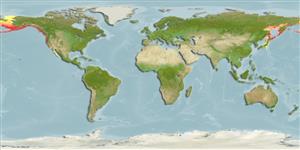Classification / Names
Common names from other countries
Main reference
Size / Weight / Age
Max length : 108 cm TL male/unsexed; (Ref. 40637); 65.5 cm (female); common length : 71.0 cm TL male/unsexed; (Ref. 593); common length :59.5 cm (female); max. published weight: 15.2 kg (Ref. 40637); max. reported age: 5 years (Ref. 36794)
Environment
Marine; freshwater; brackish; demersal; anadromous (Ref. 51243); depth range 0 - 250 m (Ref. 50550)
Climate / Range
Temperate; ? - 25°C (Ref. 35682), preferred 3°C (Ref. 107945); 72°N - 22°N, 135°E - 99°W (Ref. 54250)
Distribution
Short description
Dorsal
spines
(total): 0;
Dorsal
soft rays
(total): 9-13;
Anal
spines: 0;
Anal
soft rays: 12 - 17;
Vertebrae: 61 - 69. Characterized by the presence of small black spots on the back and on the upper lobe of the caudal fin, and by the lack of dark pigment along the gum line of the lower jaw (Ref. 27547). The gill rakers are rough and widely spaced; the lateral line is nearly straight (Ref. 27547). The adipose fin is slender; the pelvic fins have an axillary extension (Ref. 27547). Fish in the sea are dark metallic blue or greenish on the back and upper sides, a brilliant silver color on middle and lower sides, and white below; small black spots are present on the back and upper sides and on the upper lobe of the caudal fin (Ref. 27547). During the spawning season fish turn dark to bright green on head and back, bright red on the sides, and often dark on the belly (Ref. 27547). Females are less brightly colored than males (Ref. 27547).
IUCN Red List Status (Ref. 115185)
Threat to humans
Harmless
Human uses
Fisheries: highly commercial; aquaculture: commercial; gamefish: yes
Tools
Special reports
Download XML
Internet sources
Estimates of some properties based on models
Phylogenetic diversity index
PD50 = 0.5000 many relatives (e.g. carps) 0.5 - 2.0 few relatives (e.g. lungfishes)
Trophic Level
4.2 ±0.70 se; Based on food items.
Resilience
Medium, minimum population doubling time 1.4 - 4.4 years (K=0.98(?); tm=2-4; Fec=1,400)
Vulnerability
Moderate to high vulnerability (53 of 100)
Price category
